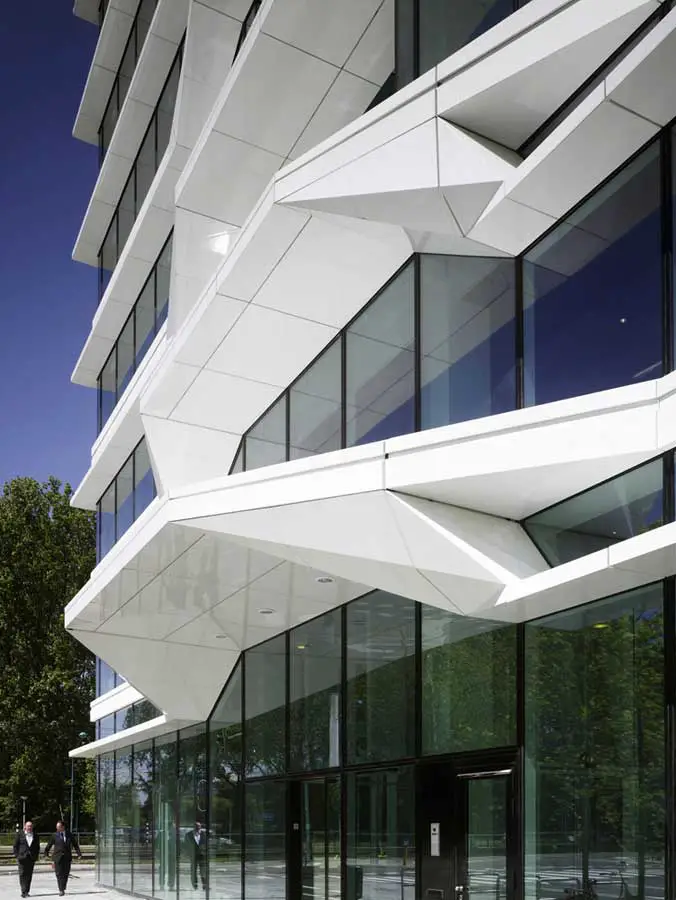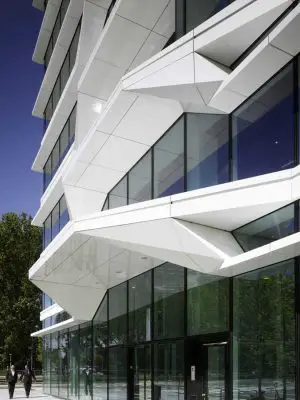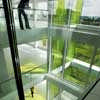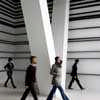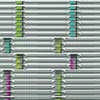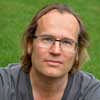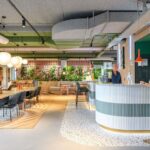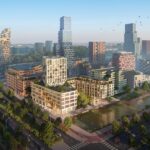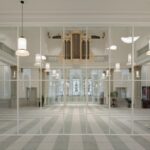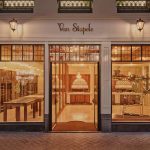UNStudio Tower Amsterdam design, Holland tall building photos, Dutch high-rise by architect
UNStudio Tower Amsterdam Mahler 4 Complex
South Axis Building at Mahler 4 Amsterdam, The Netherlands
post updated 28 December 2024
UNStudio Tower, Amsterdam, Netherlands
Dates built: 2004 – 09
Design: UNStudio Architects
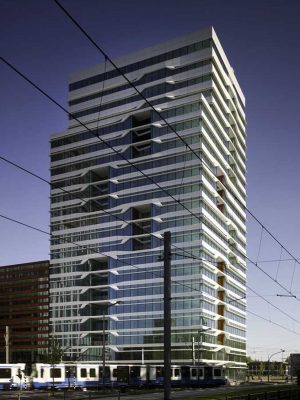
photograph © Christian Richters
post updated 2 Apr 2021 ; 22 Sep 2010
UNStudio Tower
The recently completed 21 storey UNStudio Tower forms part of the Mahler 4 urban complex, a cluster of six buildings located in the heart of the South Axis in Amsterdam. The South Axis connects Schiphol Airport to the major business areas of Amsterdam South.
The Mahler 4 urban complex houses 38.000 m2 of residential spaces, 162.000 m2 of office space and 30.000 m2 of street level retail, cafes, restaurants and a sports centre. The six towers in the Mahler 4 complex range in height from 85 to 100 meters, with each building carrying the name of its designing firm. The Mahler 4 complex has been nominated for the FGH Real Estate Prize 2010.
At a height of 82.5 meters, the UNStudio Tower contains 20 floors of office space and a ground floor with mezzanine. The Royal Bank of Scotland currently occupies 9 floors of the building and the South entrance with commercial space on the Gustav Mahlerlaan.
UNStudio Tower façade
The façade of the UNStudio Tower plays with the juxtaposition of a horizontal and vertical articulation, conceptually relating to the principles upon which the moiré effect is based.
The horizontal articulation is provided by white, aluminium bands which wrap the tower, whilst their varying size, depth and transparency ensure the correct balance of sun screening and light penetration to the interiors on all levels of the building.
Vertical accents are formed by voids, recessed into each face of the building and spanning differing numbers of floors. These voids serve to create an inside-outside relationship which extends the façade envelope and turns the surface of the tower into an active medium with a profound effect on the quality of the interior user space.
Ben van Berkel: “In the design for the tower it was important for us to create a connection between the façade and the interior spaces; to see the building as whole, almost like a piece of furniture.”
Custom coloured glass panes are incorporated into the vertical voids, offering different identities and light qualities to the communal spaces which surround each void in the interior. These voids further facilitate daylight penetration deep into the extensive 40m x 40m floors.
Voids are often placed at the center of a building, but here they are placed at the perimeters. This has three major advantages:
– The voids are easily transformed into (internal and external) balconies
– The usable floor space is larger and can be planned more flexibly. The depth of the floors further ensures a high façade to gross floor ratio, whilst the building as whole has a 90% net to gross ratio.
– The quality of the void spaces is affected by their location. Instead of public circulation space, these voids offer space for small meetings or personal reflection.
User experience
Whereas conventional office buildings with their strict separation of inside and outside can be experienced as somewhat confining by contemporary office workers, the transparency of the primarily glass façade, in combination with the vertical voids, offers the user a gradient experience of the inside-outside condition, as well as the perception of an open and light interior. The outdoor spaces which are incorporated into the recessed voids in the form of roofed balconies allow for transition from inside to outside during free time or breaks. In addition, a roof terrace with a sky view towards Amsterdam Old South can be accessed for larger outdoor gatherings.
Attaining sustainability
UNStudio sees sustainable design as an integral aspect of contemporary architecture. Sustainable solutions are not treated as add-ons, but related to each and every building element.
In the design for the UNStudio Tower integrated sustainable solutions include:
– Materials: the reduction of replacement frequency through the use of high quality durable materials and equipment throughout the building, along with the incorporation of a lightweight frame (resulting is less construction material usage in the foundations).
– Climate: the façade design incorporates sustainable considerations with respect to orientation, with lamellas of differing heights, widths and depths controlling both direct sunlight penetration and noise pollution to each face and level of the building.
– Thermal glazing allows for sufficient daylight, whilst reducing direct sunlight.
– Energy saving installations: an underground energy storage system reduces energy usage by 30 to 35.7%. Energy efficient fixtures with motion sensors further control lighting level differentiation and thermal comfort. Sanitary installations include water saving cisterns and grey water usage.
Incorporating flexibility
Flexibility with respect to future change of use with an ambition towards minimum alteration was paramount in the design of the UNStudio Tower. Extensive research was carried out in collaboration with the client in order to determine where maximum flexibility could be incorporated into the design from the outset. As a result, the floor plans of the UNStudio Tower incorporate the potential for future residential use with no structural alteration required.
The vertical voids recessed into the façade of the building also offer the potential to be transformed into individual balconies on each floor for residential use in the future. The façade design further incorporates a system whereby the glass panes can be replaced with minimum intervention should a change of use become desirable.
Ben van Berkel: “A grid system was introduced into the UNStudio Tower which creates flexibility with a view to potential change of use in the future. There are currently many empty office buildings in Europe which cannot so easily be transformed, but the UNStudio Tower is designed in such a way that it could also one day be turned into housing. This provides an essential sustainable flexibility to the building.”
UNStudio Tower Amsterdam – Building Information
UNStudio Tower, Amsterdam, Netherlands 2004-09
Project data
Client: Mahler 4 VOF, Consortium G&S Vastgoed, ASR Vastgoed, ING Real Estate
Location: Gustav Mahlerlaan, Zuid-as, Amsterdam
Program: offices
Building area: 28.280 m²
Volume: 118.878 m³
Height: 85m, 21 floors
Status/phase: Realised
Credits
UNStudio: Ben van Berkel, Gerard Loozekoot with Wouter de Jonge, Erwin Horstmanshof
And Holger Hoffman, Kristin Sandner, Miklos Deri, Jesca de Vries, Nanang Santoso, Lucas Galehr, Dennis Ruarus, Nanang Santoso.
Advisors
Executive architect: van den Oever Zaaijer & Partners
Technical Engineering: Van Rossum, Amsterdam
Installations: Techniplan, Rotterdam
Contractor: G&S bouw
Photos © Christian Richters + Inga Powilleit
UNStudio Tower Amsterdam image / information from UNStudio, Architects
UN Studio Tower, Amsterdam – Review by Olaf Kneer, architect
UN Studio’s office tower project in Amsterdam is an exercise in efficiency while attempting to carve out opportunities for moments of distinct spatial qualities.
UNStudio Tower at the Mahler 4 Complex
The project is located near the busy ring road to Schiphol airport, in a small business park next to an extensive area of housing. Ben van Berkel sets out UN Studio’s ambition by stating that he wanted the building to work now, as an office building, but also in the future, possibly converted to housing, or other uses, rather than being demolished if the office use was no longer tenable, and therefore making it particularly sustainable. This is a very interesting strategy, and sets out an ambition for longer life span of commercial buildings.
From the distance, a number of distortions in the facade, according to Ben van Berkel similar to grid shifts in a moiré pattern, define carved out areas which bring light deep into the plan. These recessed areas give a rhythm to the façade but more importantly perhaps, offer opportunities for different uses of the building in the future, an argument for the possible part or full conversion of the building for other uses. For an actual moiré effect to appear maybe these shifts would have had to have been much stronger, and less restricted to only particular areas of the façade.
The building works better probably close up than from the distance, when the strategy of making small articulated adjustments to the regular grid of the façade become more apparent and start to define the individual’s experience of the building.
Here, the façade offers a higher degree of small scale articulation, with folded façade panels providing shading, or allowing and reflecting light deep into the plan of the building. This is where the desired optical effects are perhaps more successful than from the distance, and start to offer beautiful qualities of light, shade and, through the use of chromatic glass, colour.
It is interesting to picture this building, which currently presents itself slightly clean and corporate, in a possible future scenario described by Ben van Berkel, with different users, inhabited by families, individuals of different backgrounds, small companies, studios, workshops etc. Perhaps then the building, with its generous glass windows, would from the distance appear as a moiré pattern, or more likely, a kaleidoscope.
Olaf Kneer, Sep 2010
Location: Mahler 4, Amsterdam, The Netherlands
Architecture in Amsterdam
Amsterdam Architecture Designs – chronological list
Amsterdam Architecture – contemporary building information
Amsterdam Buildings – historic building information
Architectural Walking Tours Amsterdam
Amsterdam Architecture Designs – architectural selection below:
Tripolis Park
Design: MVRDV
Tripolis Park building
Mahler 1 office building
Design: 3XN GXN
Mahler 1 office building
Dutch Architectural Designs
Major New Dutch Buildings
Netherlands Architecture Designs – chronological list
Comments / photos for the UNStudio Tower Amsterdam – Mahler 4 Building Complex desig by UNStudio architects office page welcome.

